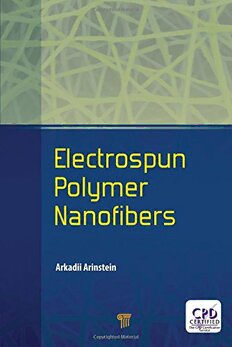
Electrospun Polymer Nanofibers PDF
Preview Electrospun Polymer Nanofibers
Electrospun Polymer Nanofibers Pan Stanford Series on Renewable Energy — Volume 2 Electrospun Polymer Nanofibers editors Preben Maegaard Arkadii Arinstein Anna Krenz Wolfgang Palz The Rise of Modern Wind Energy Wind Power for the World Published by Pan Stanford Publishing Pte. Ltd. Penthouse Level, Suntec Tower 3 8 Temasek Boulevard Singapore 038988 Email: [email protected] Web: www.panstanford.com British Library Cataloguing-in-Publication Data A catalogue record for this book is available from the British Library. Electrospun Polymer Nanofibers All rights reserved. This book, or parts thereof, may not be reproduced in any form Copyright © 2018 by Pan Stanford Publishing Pte. Ltd. or by any means, electronic or mechanical, including photocopying, recording or any information storage and retrieval system now known or to be invented, without written permission from the publisher. For photocopying of material in this volume, please pay a copying fee through the Copyright Clearance Center, Inc., 222 Rosewood Drive, Danvers, MA 01923, USA. In this case permission to photocopy is not required from the publisher. ISBN 978-981-4745-27-7 (Hardcover) ISBN 978-1-315-36462-9 (eBook) Printed in the USA Contents Preface 1. In troduc tion i1x Part I The Necessary Basics 5 2. Nano-objects 7 2.1 What “Nano-objects” Mean? 7 2.2 Physical Properties of Nano-objects Compared to the Bulk 11 2.2.1 Mechanical Properties 12 2.2.2 Thermodynamic Properties 17 3. Experim2e.n2t.a3l ExSaimzei-nDaetipoenn odfe Enlte Bcterhoaspviuonr Poof lNymaneor - objects 19 Nanofibers 21 3.1 Experimental Examination of Nanofiber Mats 23 3.2 Experimental Examination of Single Nanofiber 26 3.2.1 Atomic Force Microscopy 26 3.2.2 Tensile Test 29 Part II Nano3.f2ib.3e r FRaebsroincaatnicoen M ethod 3370 4. Electrospinning of Polymer Nanofibers 39 4.1 Spinability of Polymer Solution 41 4.2 Hydrodynamics of Electrospinning 46 4.3 Hydrodynamic Instabilities of Spinning Jet 50 4.4 Solvent Evaporation and Polymer Solidification 56 4.5 Post-fabrication Relaxation 64 4.5.1 Experimental Observations 66 4.5.2 Preliminary Estimates 68 4.5.3 Kinetic Equations Describing the System Evolution 70 4.5.4 Pressure and Velocity Distribution 71 vi Contents 4.5.5 Meniscus Moving (Kinetics of Solvent Evaporation) 72 4.5.6 Experimental Proof of Post-fabrication Relaxation 74 4.6 Post-processes in Electrospun Tubular Nanofibers 75 4.6.1 Formation of Gas Bubbles 76 5. Polymer4 D.6y.n2a mBicusc iknl iSnegm oi-fd Tiluubteu lSaor lNutainoonf Dibuerrin g 78 Electrospinning 85 5.1 Theoretical Model Describing Stretching of a Polymer Topological Network 87 5.1.1 Initial State of Entangled Semi-dilute Polymer Solution 87 5.1.2 Axial Stretching of an Entangled Polymer Network during Electrospinning 88 5.1.3 Radial Contraction of an Entangled Polymer Network during Electrospinning 92 5.2 Experimental Observations of Polymer System Evolution under High Stretching 95 5.2.1 Radial Contraction of an Entangled Polymer Network during Electrospinning 95 5.2.2 Stretch-Induced Phase Separation in Polymer Solutions 99 5.3 Disentanglement of Polymer Topological Network in Further Stages of Electrospinning 107 5.3.1 Multiple Necking 108 5.3.2 Short Fiber Fabrication 109 5.3.3 Simulation of Disentanglement Processes with the Help of a Pulley System 111 5.3.4 Spontaneous Symmetry Breaking in a Thermodynamic System of Pulleys 114 5.3.4.1 Mathematical description 115 5.3.4.2 Motion analysis 117 5.3.4.3 The energy balance 121 5.3.4.4 The thermodynamic system 122 5.3.4.5 Numerical simulations 123 Contents vii Part III Unique Properties of Electrospun Polymer Nanofibers 125 6. Size-Dependent Behavior 127 6.1 Size-Dependent Behavior of Electrospun Nanofibers 127 6.1.1 Size-Dependent Behavior in Mechanical Properties 127 6.1.2 Size-Dependent Behavior in Thermodynamic Properties 130 6.2 Do Surface Effects Explain the Unique Elasticity of Polymer Nanofibers? 132 6.3 Concept of Near-Surface Layer 138 6.4 Confinement Concept 140 6.4.1 Physical Model of the Phenomenon 142 7. Explanat6i.o4n.2s of Tthhee oSrizeet-iDcaelp Eesntdimenatt iBoenhsa vior by a 143 Physicist: Some Possible Reasons and Mechanisms 147 7.1 Confinement Mechanism of Electrospun Polymer Nanofibers Reinforcement 147 7.1.1 Structure of an Amorphous Nanofiber Polymer Matrix 150 7.1.2 Mathematical Model for Polymer Nanofiber Elongation 154 7.1.3 Scaling Properties of the Size-Dependent Elastic Modulus of Electrospun Polymer Nanofibers 159 7.2 Shifting of Melting Point for Semi-Crystalline Polymer Nanofibers 164 7.2.1 Theoretical Background 165 7.2.2 Experimental Results and Discussions 169 7.3 Nonequilibrium State of Polymer Matrix Inside Electrospun Nanofibers 171 7.3.1 Orientation of Polymer Macromolecules as a Result of Electrospinning 171 7.3.2 Stretching of Polymer Matrix of Electrospun Nanofibers 177 7.3.3 Orientation versus Stretching under Confinement 180 viii Contents Final Remarks 183 Bibliography 185 Index 193 Contents ix Preface “By making something absolutely clear, someone will become confused.” —Arthur Bloch Polymer nanofibers fabricated through electrospinning have attracted much attention recently because of their unique mechanical and thermodynamic properties compared to the bulk. Despite the prehistory of electrospinning spanning more than 100 years, the real examination of this process and its adaptation to the praxis started only 15–20 years ago. Nowadays, the hydrodynamics of the electrospinning process is well understood, which has enabled fabrication of polymer nanofibers in a regular and stable way, and electrospun polymer nanofibers are utilized for many applications. At the same time, in spite of the aforementioned progress, the physical reasons for the observed unique properties of polymer nanofibers are poorly understood. Now it is clear that the unusual properties of polymer nanofibers cannot be attributed to the surface effect, and for the explanation of the observed phenomena, the confinement concept seems the most perspective one. Nevertheless, the physical mechanisms providing the confinement effect and, as a result, the appearance of unique properties of polymer nanofibers require thorough investigation. This book clarifies (maybe, partially) the physical aspects of the problem in question, focusing on the analysis of the size-dependent Arkadii Arinstein behavior of electrospun polymer nanofibers. Fall 2017
